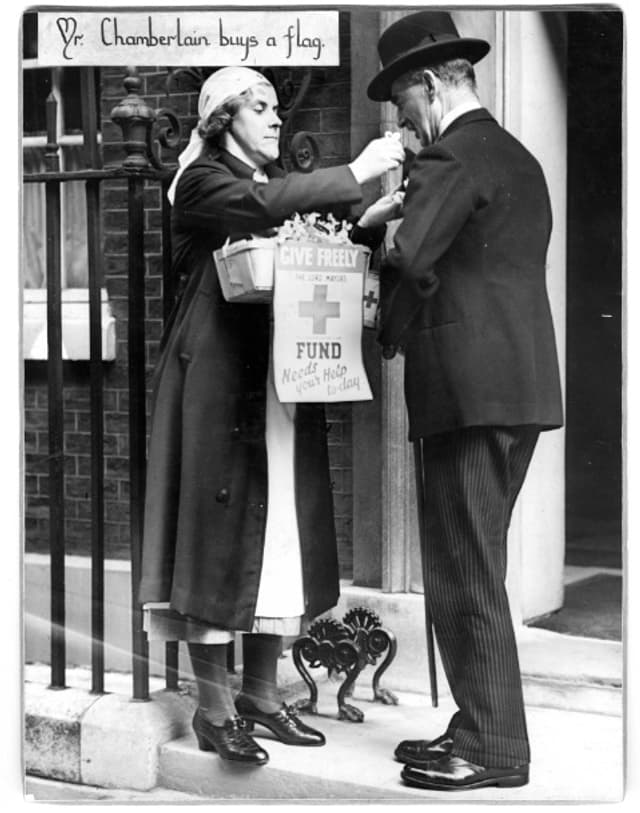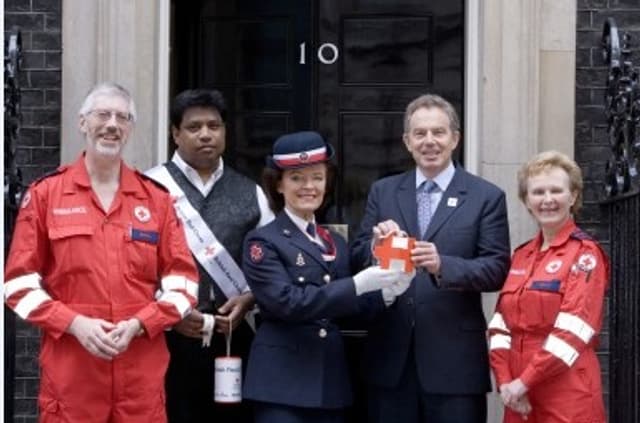British Red Cross: the £7.7 billion appeal that changed British fundraising forever
- Exhibited by
- SOFII
- Added
- September 29, 2010
- Medium of Communication
- Miscellaneous
- Target Audience
- Planned gift
- Type of Charity
- Public/society benefit
- Country of Origin
- UK
- Date of first appearance
- September, 1939
SOFII’s view
‘The most successful fundraising appeal ever.’ A mighty claim indeed but one that SOFII feels is most deserved. By pioneering fundraising methods such as house-to-house collections, penny-a-week appeals and the popularisation of charity shops, the Duke of Gloucester’s Red Cross and St John Appeal Fund raised the equivalent of £7.7 billion. As well as generating this extraordinary amount, the appeal also paved the way for many of the fundraising techniques that we rely upon today.
Name of Exhibitor
Louise Daintrey from British Red Cross
Background
The Duke of Gloucester’s Red Cross and St John Appeal Fund was launched in September 1939 to raise funds for those affected by the Second World War. By 1946 the appeal had raised £54,324,408 – which is the equivalent of £7,700,000,000 today1. That means (at the time of writing) it is the largest charitable fund ever raised in the UK. The proceeds of the fund went to the British Red Cross and St John War Organisation.
Special characteristics
The fund committee decided to run appeals targeted to particular sections of the community.
The penny-a-week fund was a scheme created with the co-operation of the Trades Union Congress (TUC) and Employers’ Organisation to collect a penny week from workers, which was deducted from their wages. The fund raised £17,663,225 (£2.5 billion today) – all in pennies.
Its success was credited to the idea of collecting a small amount of money from a large number of people. The amount did not make a significant difference to the donor’s weekly budget, but the pennies added up to raise more than one third of the entire Duke of Gloucester’s Appeal. This was the precursor to payroll giving as we know it today. In 2011/12 £118 million is donated through payroll giving in the UK currently2, a mere 34 per cent of what the penny-a-week fund collected annually during the war years.
House-to-house collections were arranged in 23 London boroughs. The collections required a new Act of Parliament, the House-to-House Collections Act of March 1940. The Act required that collectors had to be ‘fit and proper persons’, wear identification badges, carry a certificate of authority and place all the money into a sealed collecting tin.
Mrs Churchill’s Aid to Russia Fund was launched when war began between Germany and Russia in June 1941. The fund raised £7,984,000 (£984 million today) and provided clothing, blankets, medical supplies and other items to the Soviet Red Cross. The Aid to Russia Fund also paid for machinery for two factories in Russia to produce artificial limbs.
The Red Cross Agriculture Fund was supported by the National Farmers’ Union and organised sales, auctions, dog shows and onion-growing schemes. The Royal Horticultural Society sent parcels of vegetable and flower seeds to prisoner of war (POW) camps in Germany and Italy. In 1946, in Great Windsor Park, King George VI planted nine red oak trees in the shape of a cross to commemorate the Red Cross Agriculture Fund where they remain to this day.
Various specialist committees were set up to contribute to the fund including the sports committee, theatre committee and the numismatic committee, which collected over a million coins for sale at auction.
Furthermore, 200 permanent and 150 temporary charity shops were opened to benefit the fund. The stocks were made up entirely of donated items. The phenomenon of a chain of charity shops between 1939 and 1945 – before Oxfam was born – pointed the way for the subsequent massive growth in charity shops over the following years. It is estimated that, at the time of writing, there are now over 10,200 charity shops in the UK3.
Twelve flag days were organised during the war, raising £2,668,826 (£378 million today). Christie’s held auctions of gifts in kind in aid of the appeal. Other initiatives included the Red Cross and St John book campaign and the stamp appeal.
Numerous events were held in aid of the appeal including films, exhibitions, galas and concerts. Gracie Fields performed at a gala in the Albert Hall in 1941 and Yehudi Menuhin gave a concert in September 1944.
All sections of society were involved in the appeal and large support was provided by schools, churches and children. Dentists did their bit by donating proceeds from the sale of the metal from used toothpaste tubes to the fund.
The appeal closed on 30th June 1945 having raised an unprecedented £54,324,408 (£7.7 billion).
The American Red Cross also ran an appeal and raised an astonishing $784 million4 (£177,000,000 then or £25 billion today) from the American public. Needless to say other Red Cross societies undertook similar appeals during the war.
When one considers that £4.3 billion was pledged internationally for the 2004 Asian tsunami, it is clear that no UK fundraising appeal has ever been as successful as The Duke of Gloucester’s Red Cross and St John appeal. The appeal allowed the British public to come together to help directly those affected by the Second World War. The public’s generosity is all the more remarkable as the money was raised at a time when the country was tightening its belt and ‘make do and mend’ and rationing were the norm.
- Today’s figures are based on average earnings in 1945 compared to 2009, calculated at the time this case study was written. http://www.measuringworth.com/ukcompare/
- https://www.gov.uk/government/news/government-consults-on-reforms-to-improve-payroll-giving-for-charities-and-donors--2
- http://www.charityshops.org.uk/faqs_shop.htm
- http://www.redcross.org/museum/history/ww2a.asp
Influence/Impact
The Duke of Gloucester’s Red Cross and St John Appeal Fund saved countless lives during the Second World War and contributed three quarters of the income of the Red Cross and St John War Organisation.
The War Organisation sent food parcels to prisoners of war every week. In total 19 million parcels were sent to 180,000 people. The War Organisation undertook numerous other activities to assist those affected by the war, including a messaging service, setting up hospitals and convalescent homes, providing ambulances and transporting goods and equipment.
‘Everyone was unanimous in heartfelt gratitude to the Red Cross, whose parcels of food and clothing make the difference between life and death…the Red Cross virtually saved them from starvation.’
The Times, March 1943.
‘How can I ever express what I feel about the Red Cross?...like a bright shining star in the darkness of our night we know the Red Cross was there and that it would reach us if it could, and at last, thank God, it did reach us.’
Colonel Mary Booth, granddaughter of the founder of the Salvation Army, having recently returned after two and a half years in German prison and internment camps, June 1943.
At the end of the war, Red Cross workers set up medical and rehabilitation services for those liberated from concentration camps.
‘I came away filled with admiration for our Red Cross teams who are so bravely battling with the grim job they have been asked to undertake here.’ The Times Red Cross correspondent at Belsen concentration camp, May 1945.
Merits
The Duke of Gloucester’s Red Cross and St John Appeal Fund is the largest charitable fund in the history of British fundraising, raising the equivalent of £7.7 billion. The appeal led to many fundraising innovations including legislation to allow house-to-house collections and the popularisation of charity shops and allowed the public to express their solidarity with people whose lives had been torn apart by war.
 View original image
View original image
 View original image
View original image
 View original image
View original image

















